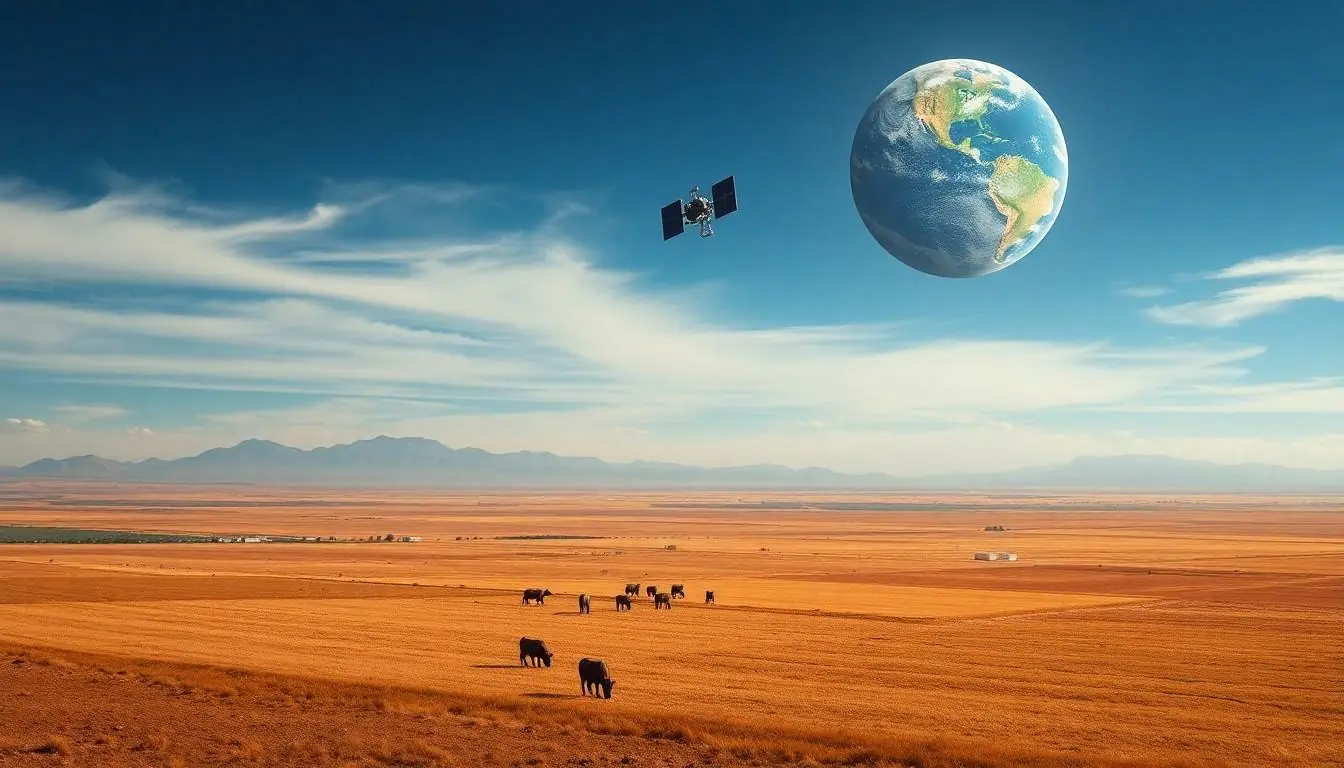Table of Contents
ToggleIn a world where everything seems to be getting smarter, satellite IoT is the ultimate game-changer. Imagine your fridge sending a message to your phone saying it’s out of milk while you’re on a beach in Bali. Sounds like sci-fi, right? But with satellite IoT, this futuristic scenario is becoming a reality, connecting devices in even the most remote corners of the globe.
Overview of Satellite IoT
Satellite IoT revolutionizes how devices connect globally, particularly in remote or rural areas. It employs satellites to deliver reliable communication where traditional cellular infrastructure falls short. Enabling technologies like low Earth orbit satellites can provide near real-time data transmission, enhancing operational efficiency across various industries.
Applications span agriculture, transportation, and logistics. Smart farming benefits immensely from sensors that monitor soil moisture, temperature, and crop health, all relayed via satellite. Transportation sectors utilize satellite IoT for fleet management, providing critical data on vehicle locations, maintenance needs, and driver behaviors.
Challenges exist, such as latency or coverage gaps. However, advancements in satellite technologies strive to address these issues, making satellite IoT increasingly viable. Companies increasingly invest in satellite networks to enhance their IoT capabilities, ensuring connectivity across expansive landscapes.
Market growth exemplifies the technology’s rising importance, with reports projecting the satellite IoT market to reach $14 billion by 2026. Forecasts indicate significant adoption driven by industries leveraging satellite connectivity for innovative solutions. Continuous development in satellite technologies promises expanded capabilities, transforming everyday functions, like refrigerators notifying users of low supplies, into seamless, automated tasks.
Satellite IoT stands as a critical enabler of global connectivity, connecting diverse devices across industries while addressing real-time needs in challenging environments.
Benefits of Satellite IoT

Satellite IoT offers numerous advantages, especially in enhancing connectivity and operational efficiency.
Global Coverage
Global coverage represents a primary benefit of satellite IoT. Low Earth orbit satellites allow device connectivity in remote and underserved areas. Many regions that lack traditional cellular networks can access satellite communication. Industries such as agriculture and disaster management rely on this expansive reach. Resource-strapped areas receive critical data about weather and soil conditions. The ability to communicate from anywhere empowers businesses in logistics and environmental monitoring. For example, ranchers can track livestock far from urban centers. Overall, global coverage ensures vital connectivity regardless of location.
Reliable Connectivity
Reliable connectivity is crucial for IoT applications. Satellite IoT systems provide consistent data transmission even in challenging environments. Devices equipped with satellite communication maintain functionality in areas prone to natural disasters or disruptions. Robust architecture ensures that crucial data flows uninterrupted. Fleet operators use this technology to monitor vehicles in real-time. Mining and exploration companies gain insights from remote sensors without loss of connectivity. In sectors where downtime proves costly, satellite IoT offers an edge. Solutions become dependable, turning potential disruptions into seamless operations.
Applications of Satellite IoT
Satellite IoT has numerous applications across various industries, enhancing connectivity and communication in previously underserved areas.
Agriculture
Agriculture benefits significantly from satellite IoT technology. Farmers use sensors linked via satellites to monitor soil moisture, nutrient levels, and weather conditions. This data-driven approach leads to optimized irrigation and fertilization practices. Producers report increased crop yields and reduced resource waste thanks to precise monitoring. In remote regions, satellite IoT provides connectivity where terrestrial networks fall short, allowing farmers to make informed decisions. Advanced analytics combine with real-time data for a transformative impact on agricultural operations.
Disaster Management
Disaster management improves through the integration of satellite IoT. Emergency responders utilize satellite data to assess damage and coordinate relief efforts efficiently. During natural disasters, organizations rely on real-time information from various sensors for timely decision-making. Satellite IoT enables the deployment of drones to deliver supplies and gather data in hard-to-reach areas. This approach enhances situational awareness, ultimately saving lives and resources. Predictive analytics assist in preparing communities for disasters by monitoring environmental changes and alerting officials to potential threats.
Smart Cities
Smart cities harness satellite IoT for improved infrastructure management and public services. Sensors deployed throughout urban areas collect data on traffic patterns, air quality, and energy consumption. This information allows city planners to optimize resources, reduce congestion, and enhance the overall quality of life. For example, transportation systems use real-time data to adjust traffic signals and inform commuters about delays. Additionally, satellite IoT supports environmental monitoring, aiding in sustainability initiatives. As more cities adopt this technology, the integration of services becomes seamless and efficient, making urban living more connected and responsive.
Challenges in Satellite IoT
Satellite IoT faces several challenges that affect its widespread adoption and efficiency. These obstacles include cost considerations and technical limitations, both of which influence how industries integrate this technology.
Cost Considerations
High deployment and operational costs pose significant challenges for satellite IoT. Satellite launches and maintenance require substantial investment. As a result, companies often hesitate to embrace satellite solutions, especially small to medium enterprises. Additionally, subscription fees for data transmission can accumulate quickly, impacting budget-conscious organizations. Ultimately, lower costs or improved ROI will encourage broader adoption across various sectors.
Technical Limitations
Technical limitations create barriers for satellite IoT implementation. Latency issues arise due to the distance between satellites and ground devices, causing delays in data transmission. Coverage gaps also exist, particularly in regions where satellite networks are less developed. Moreover, environmental factors can hinder signal quality, affecting overall reliability. Addressing these technical challenges remains essential for improving the performance and efficiency of satellite IoT applications.
Future Trends in Satellite IoT
Emerging trends indicate significant advancements in satellite IoT technology. Increased integration with artificial intelligence enhances data analysis capabilities, fostering smarter decision-making in real time. Low Earth orbit satellite constellations are becoming more prevalent, leading to lower latency and improved connectivity for devices in remote locations.
The proliferation of edge computing plays a crucial role in processing data closer to the source. By minimizing delays, it ensures faster data transmission and response times. Additionally, the introduction of miniaturized sensors enables widespread deployment across various industries, making it easier to collect crucial data in previously hard-to-reach areas.
Investment in sustainability drives innovation in satellite technology. Many companies now prioritize environmentally friendly practices in satellite manufacturing and operations. Collaborative efforts between satellite operators and telecommunication firms create more robust solutions, expanding service availability and reducing costs for end users.
Data security remains a primary concern amid the expansion of satellite IoT. Enhanced encryption methods protect sensitive information as connectivity grows. Regulatory frameworks are emerging to address privacy issues, ensuring compliance while promoting innovation in the sector.
Market forecasts predict that the satellite IoT sector may reach $14 billion by 2026, demonstrating the technology’s soaring demand. Various industries, including agriculture, logistics, and smart cities, increasingly adopt satellite IoT to optimize operations and improve efficiency. As devices become more interconnected, businesses will leverage satellite IoT to unlock new opportunities for growth and innovation.
Satellite IoT is reshaping how industries operate by providing unparalleled connectivity in remote areas. This technology not only enhances operational efficiency but also empowers businesses with real-time data for informed decision-making. As advancements continue to emerge alongside growing market demand, the potential applications for satellite IoT will expand further.
The challenges that exist today will likely be addressed through innovation and investment, paving the way for more accessible solutions. With its ability to connect devices globally, satellite IoT stands poised to be a game changer across various sectors, from agriculture to disaster management. The future looks bright as organizations harness this technology to drive growth and foster sustainable practices.







